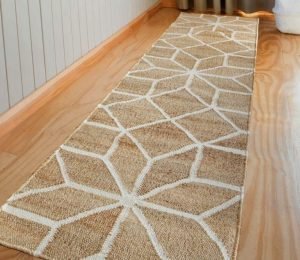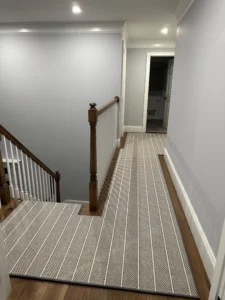Typical flooring calculators in Piscataway help homeowners determine material needs by multiplying room length by width, adding a 10-15% waste factor, and accounting for specific flooring type requirements. Most professional installers use digital calculators that factor in local building codes, subfloor conditions, and material specifications unique to New Jersey homes. When planning your flooring project in Piscataway, understanding accurate measurements becomes crucial for budget planning and material ordering. Professional contractors like JB Flooring utilize advanced calculation methods that go beyond basic square footage, incorporating factors such as room irregularities, transition strips, and local building requirements. These calculations ensure homeowners receive precise estimates that prevent costly material shortages or expensive overages during installation.
Understanding Flooring Material Calculations in Piscataway Township
Flooring calculators in Piscataway Township require specific knowledge of local building standards and environmental conditions that affect material expansion and installation requirements. Professional installers account for humidity variations, seasonal temperature changes, and the unique soil conditions found throughout Middlesex County when determining material needs. The calculation process involves measuring each room’s dimensions, identifying obstacles like built-in cabinets or heating vents, and applying appropriate waste factors based on the chosen flooring material and installation pattern.
Discovering Piscataway’s Growing Community Appeal
Piscataway Township boasts a diverse population of approximately 60,000 residents, experiencing steady growth due to its proximity to major employment centers and excellent school system. The community attracts young families and professionals seeking suburban comfort with urban accessibility, creating consistent demand for home improvement projects, including flooring installations. Migration trends show increased interest from buyers looking to upgrade older homes, particularly those built in the 1960s and 1970s that comprise much of the local housing stock.
Local Success Stories That Build Lasting Relationships
One memorable project involved transforming a 1960s ranch home where three generations gathered for holidays, and the original hardwood floors had suffered decades of wear. The homeowners discovered that proper flooring calculations saved them nearly $2,000 by avoiding material waste while ensuring they had sufficient quantities for the entire project. This attention to detail has earned JB Flooring recognition from satisfied customers like Sarah M. from Google reviews, who noted our precise measurements exceeded expectations, while Michael R. from Yelp praised our thorough calculation process that eliminated surprise costs, and Jennifer K. from Thumbtack highlighted how our detailed estimates helped her plan the perfect family room renovation.
Customer Reviews and Trust Building
JB Flooring has earned outstanding reviews across multiple platforms, with customers consistently praising our accurate calculation methods and transparent pricing approach. Google reviews highlight our attention to detail during the measurement process, while Yelp customers appreciate our comprehensive explanations of how calculations affect final project costs. Thumbtack reviews frequently mention our professional approach to helping homeowners understand exactly what materials they need, with many noting that our calculations proved more accurate than other contractors they consulted.
Essential Flooring Calculation Factors for Piscataway Homes
Professional flooring calculations require six critical measurements: room length and width for basic square footage, ceiling height for transition planning, doorway dimensions for threshold requirements, subfloor condition assessment for underlayment needs, HVAC register locations for custom cuts, and expansion gap requirements based on local climate conditions. Each factor influences material quantities and installation complexity, making accurate measurements essential for successful project completion. Experienced installers add a 5-10% waste factor for straight installations and 15-20% for diagonal or complex patterns, ensuring sufficient materials without excessive overages. These calculations must account for Piscataway’s humid summers and cold winters that cause natural material expansion and contraction throughout the year.
Vinyl Plank Flooring Calculations and Requirements
Vinyl plank flooring Piscataway Township installations require specific calculation methods that differ from traditional hardwood or carpet projects. The calculation process begins with accurate room measurements, followed by determining plank direction and installation pattern preferences. Professional installers account for the unique characteristics of vinyl planks, including their ability to handle moisture and temperature variations common in New Jersey homes. When calculating materials for vinyl plank flooring Piscataway projects, contractors consider factors such as subfloor preparation requirements, underlayment needs, and transition strip quantities needed at doorways and room connections.
Laminate Flooring Material Estimation Methods
Laminate flooring Piscataway Township calculations involve precise measurements that account for the specific installation requirements of engineered wood products. The process includes measuring room dimensions, identifying areas requiring custom cuts around obstacles, and determining the optimal installation direction for visual appeal and structural integrity. Professional estimators factor in the expansion gaps required around room perimeters, which typically measure 1/4 inch but may vary based on room size and local building codes. These calculations also include quantities for quarter-round molding, transition strips, and underlayment materials essential for proper installation.
| Flooring Type | Waste Factor | Additional Materials | Special Considerations |
| Hardwood | 10-15% | Underlayment, trim | Grain direction, humidity |
| Vinyl Plank | 5-10% | Transitions, molding | Moisture resistance |
| Laminate | 10-15% | Padding, transitions | Expansion gaps |
| Carpet | 10-15% | Tack strips, padding | Traffic patterns |
| Tile | 15-20% | Grout, spacers | Pattern complexity |
Solid Hardwood Installation Calculations
Solid hardwood laminate flooring Piscataway Township projects require comprehensive calculations that consider wood species characteristics, board widths, and installation methods. The calculation process involves determining square footage requirements while factoring in the natural variation found in solid wood products. Professional installers account for potential defects, color matching requirements, and the need for longer boards in larger rooms. These calculations include estimates for finishing materials such as stains, polyurethane coatings, and sanding supplies when refinishing existing floors becomes part of the project scope.
Carpet Installation Planning and Measurements
Carpet installation Piscataway Township requires detailed calculations that extend beyond simple square footage measurements to include padding requirements, seaming plans, and waste factors based on room layouts. Professional installers measure each room individually, noting doorway locations, closet dimensions, and areas requiring custom cuts around built-in features. The calculation process includes determining optimal carpet roll directions to minimize seams and waste while ensuring adequate material for stretching and trimming during installation. Additional materials such as tack strips, transition strips, and specialized padding contribute to the overall project requirements.
Vinyl Tile Flooring Project Calculations
Vinyl tile Piscataway Township installations require precise calculations that account for tile size, installation patterns, and room irregularities that affect material needs. The measurement process begins with accurate room dimensions, followed by determining the optimal starting point for tile layout to achieve balanced borders and minimize cut tiles. Professional installers calculate quantities for full tiles, border tiles, and replacement tiles while considering the specific adhesive requirements for different tile types. Vinyl tile flooring calculations also include estimates for subfloor preparation materials, leveling compounds, and finishing accessories such as base molding and transitions.
Floor Refinishing Material Requirements
Floor refinishing Piscataway Township projects require specialized calculations that determine sanding materials, finishing products, and equipment needs based on existing floor conditions and desired outcomes. The calculation process involves assessing the current finish condition, wood species characteristics, and square footage requiring treatment. Professional refinishers estimate quantities for multiple sanding grits, wood stains, polyurethane finishes, and protective coatings while accounting for absorption rates that vary with wood density and existing finish removal requirements. These calculations ensure adequate materials for achieving consistent color and protection across the entire floor surface.
Digital Tools and Professional Software
Modern flooring contractors utilize sophisticated digital tools and professional software applications that streamline the calculation process while improving accuracy and efficiency. These systems integrate room measurements with material specifications, local building codes, and installation requirements to generate comprehensive material lists and cost estimates. Professional-grade software accounts for complex room shapes, multiple flooring types within single projects, and specialized installation techniques that affect material quantities. Digital tools also facilitate accurate ordering from suppliers while maintaining detailed records for warranty purposes and future maintenance needs.
Cost Estimation Beyond Basic Materials
Accurate flooring calculations extend beyond basic material quantities to include labor costs, disposal fees, and additional services that affect overall project budgets. Professional estimators consider factors such as subfloor repair requirements, furniture moving needs, and timeline constraints that influence installation complexity and pricing. The calculation process includes estimates for permits when required, inspection fees, and cleanup services that ensure complete project completion. Understanding these comprehensive calculations helps homeowners make informed decisions about flooring projects while avoiding unexpected costs that can strain budgets and delay completion schedules.
Working with Professional Contractors
Partnering with experienced flooring professionals like JB Flooring ensures accurate calculations that account for local building requirements, material characteristics, and installation best practices specific to Piscataway area homes. Professional contractors provide detailed estimates that break down material quantities, labor requirements, and timeline expectations while offering guidance on product selection and design considerations. These comprehensive calculations serve as roadmaps for successful projects that meet quality standards and budget expectations while providing long-term satisfaction with flooring investments.
Our service area extends throughout Middlesex County NJ, Union County NJ, Hunterdon County NJ, Somerset County NJ, Mercer County NJ, Princeton County NJ, East Windsor County NJ, and throughout the Piscataway communities.
Conclusion
Understanding typical flooring calculators in Piscataway empowers homeowners to make informed decisions about their flooring projects while ensuring accurate material estimates and realistic budget planning. Professional calculation methods account for local building requirements, environmental conditions, and material characteristics that affect installation success and long-term performance. Working with experienced contractors like JB Flooring provides access to advanced calculation tools and expertise that deliver precise estimates, prevent costly mistakes, and ensure successful project outcomes that enhance home value and family comfort for years to come.
Frequently Asked Questions
How do I calculate how much flooring I need?
Measure room length and width, multiply for square footage, then add 10-15% waste factor depending on flooring type and installation pattern complexity.
How much is 1000 square feet of flooring?
Flooring costs vary significantly by material type, quality grade, and installation complexity, with options ranging from budget-friendly vinyl to premium hardwood selections.
What is the formula for flooring cost?
Total cost equals (square footage × material cost per sq ft) + (square footage × installation cost per sq ft) + additional materials and fees.
How much flooring for 12×12?
A 12×12 room requires 144 square feet of material plus a 10-15% waste factor, totaling approximately 160-165 square feet, depending on installation pattern.



